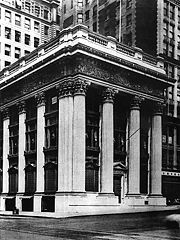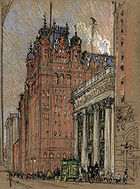
Knickerbocker Trust Company
Encyclopedia

Bank
A bank is a financial institution that serves as a financial intermediary. The term "bank" may refer to one of several related types of entities:...
s in the United States
United States
The United States of America is a federal constitutional republic comprising fifty states and a federal district...
and a central player in the Panic of 1907
Panic of 1907
The Panic of 1907, also known as the 1907 Bankers' Panic, was a financial crisis that occurred in the United States when the New York Stock Exchange fell almost 50% from its peak the previous year. Panic occurred, as this was during a time of economic recession, and there were numerous runs on...
. As a trust company
Trust company
A trust company is a corporation, especially a commercial bank, organized to perform the fiduciary of trusts and agencies. It is normally owned by one of three types of structures: an independent partnership, a bank, or a law firm, each of which specializes in being a trustee of various kinds of...
, its main business was serving as trustee for individuals, corporations and estates. Eldridge was the founding president; he was succeeded in the 1890s by Robert MacClay, with Charles T. Barney
Charles T. Barney
Charles Tracy Barney was the president of the Knickerbocker Trust Company, the collapse of which shortly before Barney's death sparked the Panic of 1907.-Early life and marriage:...
as vice president. When MacClay retired in 1897, Barney was elected president. The New York City
New York City
New York is the most populous city in the United States and the center of the New York Metropolitan Area, one of the most populous metropolitan areas in the world. New York exerts a significant impact upon global commerce, finance, media, art, fashion, research, technology, education, and...
bank was housed in a Roman-style temple designed by McKim, Mead, and White
McKim, Mead, and White
McKim, Mead & White was a prominent American architectural firm at the turn of the twentieth century and in the history of American architecture. The firm's founding partners were Charles Follen McKim , William Rutherford Mead and Stanford White...
and erected between 1902 and 1904 (illustrated) at the northwest corner of 34th Street and Fifth Avenue. Stanford White
Stanford White
Stanford White was an American architect and partner in the architectural firm of McKim, Mead & White, the frontrunner among Beaux-Arts firms. He designed a long series of houses for the rich and the very rich, and various public, institutional, and religious buildings, some of which can be found...
's design allowed for the possibility of adding nine storeys of offices upon the structure, but they were never realized. It had branch offices at 60 Broadway, in Harlem
Harlem
Harlem is a neighborhood in the New York City borough of Manhattan, which since the 1920s has been a major African-American residential, cultural and business center. Originally a Dutch village, formally organized in 1658, it is named after the city of Haarlem in the Netherlands...
and The Bronx
The Bronx
The Bronx is the northernmost of the five boroughs of New York City. It is also known as Bronx County, the last of the 62 counties of New York State to be incorporated...
.
In 1907, its funds were being used by then-president Charles T. Barney in a plan to drive up the cost of copper
Copper
Copper is a chemical element with the symbol Cu and atomic number 29. It is a ductile metal with very high thermal and electrical conductivity. Pure copper is soft and malleable; an exposed surface has a reddish-orange tarnish...
by cornering the market
Cornering the market
In finance, to corner the market is to get sufficient control of a particular stock, commodity, or other asset to allow the price to be manipulated. Another definition: "To have the greatest market share in a particular industry without having a monopoly...
. This gamble came undone due to the dumping of millions of dollars in copper into the market to stop a hostile takeover in an unrelated organization. This became public, and on October 21 the National Bank of Commerce announced that it would stop accepting checks for the Knickerbocker Trust Company, triggering a run of depositors demanding their funds back. Charles Barney requested a meeting with J.P. Morgan to discuss financial assistance for the bank, but was rejected. Because of this and the failure of the bank, he shot himself on November 14, 1907.

Dow Jones Industrial Average
The Dow Jones Industrial Average , also called the Industrial Average, the Dow Jones, the Dow 30, or simply the Dow, is a stock market index, and one of several indices created by Wall Street Journal editor and Dow Jones & Company co-founder Charles Dow...
lose 48% of its value from January 1906 to November 1907. The banking crisis is also seen as the final straw that led Congress
United States Congress
The United States Congress is the bicameral legislature of the federal government of the United States, consisting of the Senate and the House of Representatives. The Congress meets in the United States Capitol in Washington, D.C....
to form the Federal Reserve System
Federal Reserve System
The Federal Reserve System is the central banking system of the United States. It was created on December 23, 1913 with the enactment of the Federal Reserve Act, largely in response to a series of financial panics, particularly a severe panic in 1907...
in 1913.
The company reopened some weeks after its forced closing and paid off all depositors in full with interest. In 1912, its assets were acquired by the Columbia Trust Company, forming the Columbia-Knickerbocker Trust Company. This entity was acquired by the Irving Trust Corporation in 1923, which was in turn acquired by the Bank of New York
Bank of New York
The Bank of New York was a global financial services company established in 1784 by the American Founding Father Alexander Hamilton. It existed until its merger with the Mellon Financial Corporation on July 2, 2007...
in 1989.
The building was enlarged by ten stories in 1921, and the façade
Facade
A facade or façade is generally one exterior side of a building, usually, but not always, the front. The word comes from the French language, literally meaning "frontage" or "face"....
completely redesigned in 1958, with its signature pilaster
Pilaster
A pilaster is a slightly-projecting column built into or applied to the face of a wall. Most commonly flattened or rectangular in form, pilasters can also take a half-round form or the shape of any type of column, including tortile....
s covered over; it still remains, but its original form is unrecognizable.
Sources
- John Steele Gordon, The Great Game: The Emergence of Wall Street as a World Power 1999.
- Edward Ten Broeck Perine, The Story of the Trust Companies, 1916.

